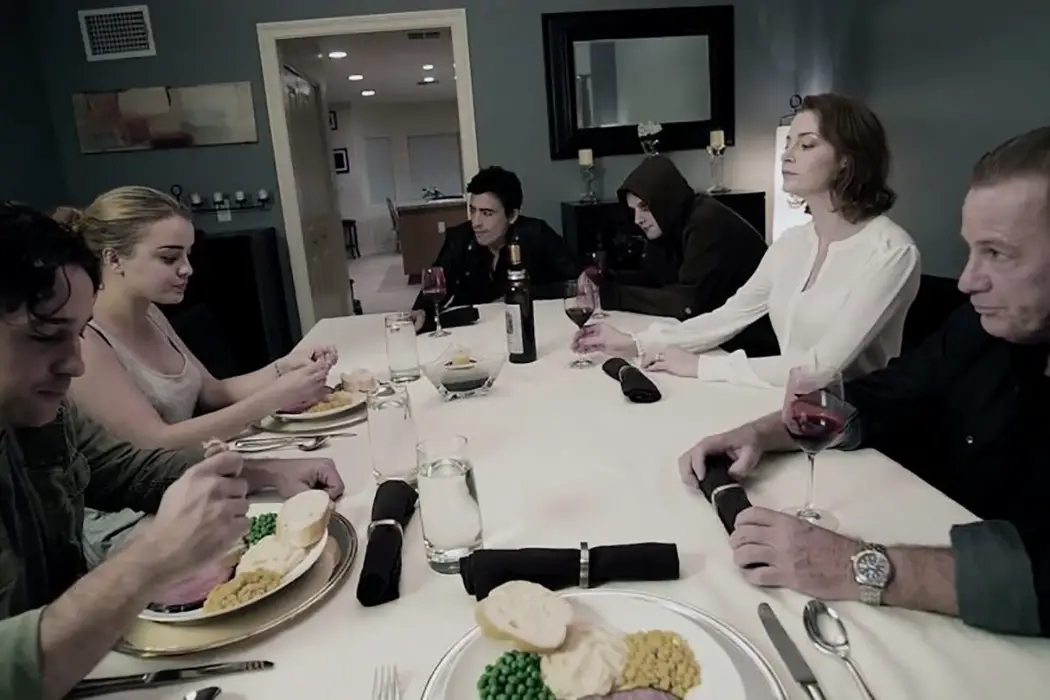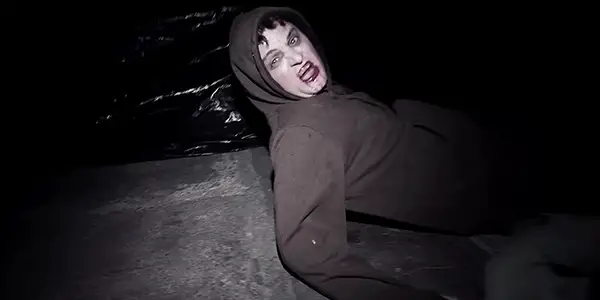LIVING AMONG US: A Product Of A Dying Art

Amyana Bartley is a screenwriter and producer. Her company, Queen…
Living Among Us is a new fantasy/horror written and directed by Brian A. Metcalf. Though the vampire genre has been beaten like a dead horse, when I saw this trailer, I thought maybe I’d be pleasantly surprised with a new twist. Unfortunately, it’s just another cliché of a cliché.
In the vein of past films like Cloverfield, Paranormal Activity and Interview With the Vampire (the film, not the book), we get yet another “found footage” wreck, without even the richness of the time period of Interview to make it remotely interesting.
Show, Don’t Tell
The film opens with a news story montage, telling us about a documentary filmmaker, Mike (Thomas Ian Nicholas), who has outed vampires, once hidden, that are blending in with regular humanity. The vampirism is caused by yet another “virus” that changes people to monsters. An elder vampire, Samuel (William Sadler), tries to calm the public by assuring them vampires aren’t monsters and that they just want the same living rights as regular people. He invites Mike and his film crew to interview and record a vampire family, to prove their harmlessness to the public. Gee, will they make it out alive?
In an excruciatingly long beginning, we watch the crew set up, prepare, figure out what they can and can’t bring to the house and watch as the filmmakers project the plot twists by drawing overtly obvious attention to certain objects. When they arrive at the vampire’s home, it is more exposition, boring interviews and no action.

The “family” consists of Elleanor (Esme Bianco), the “mother; Andrew (John Heard), the “father”, Blake (Andrew Keegan), the “son” with the only whiff of character development; and Selvin (Chad Todhunter), the dark and broody “son” you know wants to kill everyone. The crew is told the “rules” of the house, i.e. no recording their “rituals” and don’t go in the basement, which, of course, we know won’t be heeded.
Over THIRTY minutes of an eighty-seven minute film passes before we even get a “what was that” moment from a crew member, in, what is supposed to be a horror film. After just five minutes, I found my attention waning and moving to my phone.
The Death of Screenwriting
John Patrick Shanley, whose screenwriting credits include 1987’s Moonstruck and 2008’s Doubt, is quoted to have said that trying to make a film without a good script is “like trying to build a house without any bricks”.
I am astounded by how many films today, even huge blockbusters, have terrible to non-existent scripts and still get greenlit. I think this is what happens when ego and executives who know nothing about art get to call what gets made and what doesn’t. Even last year’s “hit” Thor: Ragnarok was said to be 80% improvised. I heard about this after I wrote my review on it, but to me, it was obvious. Ragnarok was riddled with inconsistencies, bumbling dialogue, no character development, nor any real hero transformation.

Having spent over 20 years learning the art of and writing screenplays myself, Living Among Us‘s script came across like a first-timer’s, first draft effort. With a painful amount of exposition, it is acutely predictable, with no subtlety; and most of the actors, a couple legendary, paddled around awkwardly, attempting to make something of the languid dialogue and lack of story. There are no new twists making these vampires any different from every other story, nor effects distinguishing it from all other found footage films.
In the best part of Living Among Us, deranged Blake goes against the wishes of his “parents” and takes Mike, Benny, and Selvin with him out on a night of hunting. Blake is hellbent on becoming famous, so does anything for a “good shot”, including burning his own arm in the sunlight. They go to a house of people deemed as “just druggies” – a lazy justification for murder from the screenplay – and display, on camera, the best blood bath scene of the movie. Here we finally experience a bit of the savagery we expect from vampire films that aren’t Twilight.

Living Among Us: Why?
Other than that there is no defending this film. I found myself angry after watching it. Angry that it wasted 87 minutes of my life. Angry, that with all of the talent out there, this is one of the projects dubbed good enough to invest money and time on. But mostly, I was livid with whomever it was that greenlit this film, the way it was. It’s sad that William Sadler wasted his talent on this and even sadder that this was John Heard‘s last feature before his death.
Other reviewers have compared this to Taika Waititi‘s What We Do In the Shadows. Considering What We Do In The Shadows‘ brilliance, there is no comparison between the two except the presence of vampires. Instead, why not compare it to Waititi‘s Thor: Ragnarok, yet another poorly planned improviso, lacking direction, depth, story, character development and the ability to engage the viewer. Ragnarok was better, though only because it had more money to bring cooler special effects and heavyweight stars. But what’s the bigger tragedy; spending a lot of money, or less money, on crap?
It seriously makes me concerned about the future of film. Without great writers, will movies come down to computer generated ideas and then fumblingly improvised out? Every movie doesn’t need to be a deep think piece, but it should have a point and characters that move us, or at least keep us interested. There’s no argument to be had for me. Just like the bricks building the foundation of a strong house, there are no great films without a great script.
What do you think about the evolution of modern films?
Living Among Us is available on VOD and in select theaters in the US.
Does content like this matter to you?
Become a Member and support film journalism. Unlock access to all of Film Inquiry`s great articles. Join a community of like-minded readers who are passionate about cinema - get access to our private members Network, give back to independent filmmakers, and more.
Amyana Bartley is a screenwriter and producer. Her company, Queen B. Productions, supports filmmakers of all walks, interested in creating thought provoking, moving projects. As her company grows, she will create "real jobs" for any talented artist, in front of and behind the screen, who is passionate about making a difference using the art of film.













